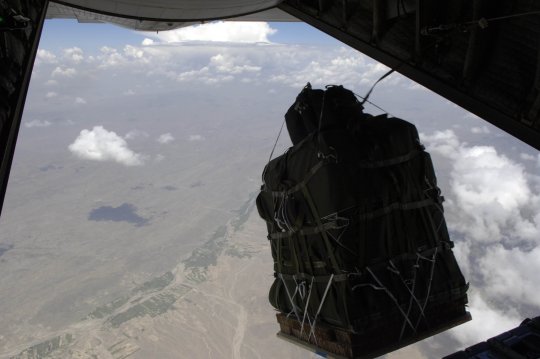
A new GPS-guided “Screamer” bundle from the Joint Precision Air Drop System falls out the back of a C-130 Hercules over Afghanistan Aug. 26. The drop was made from 17,500 feet above mean sea level and was the first joint Air Force-Army operational drop of JPADS in the Central Command area of responsibility. Four bundles were dropped from the Alaska Air National Guard C-130. The system is designed to provide precision airdrops from high altitudes, eliminating the threat of small-arms fire. All four bundles arrived less than 25 meters from the desired target. Photo by Senior Airman Brian Ferguson, USAF

Bagram C-130s drop high-tech cargo delivery system
Tech. Sergeants Steven Hayes and Luzmarina Arevalo install the center vertical restraint in a C-130 Hercules Aug. 25. Sergeant Hayes is a loadmaster and Joint Precision Air Drop System, or JPADS, trainer from the Air Mobility Warfare Center. Sergeant Arevalo is a loadmaster with the 774th Expeditionary Airlift Squadron. The 774th EAS performed the first operational drop of a new Global Positioning System-guided JPADS bundle. (U.S. Air Force photo/Senior Airman Brian Ferguson)

Army Spc. Oscar Osorio attaches the parachute activation cord of a Joint Precision Air Drop System bundle to a C-130 Hercules static line before an airdrop over Afghanistan Aug. 31. Specialist Copley is a parachute rigger with the 647th Quartermaster Detachment. (U.S. Air Force photo/Senior Airman Brian Ferguson)
Bagram C-130s Use High-Tech Cargo Delivery System
DOD
The same global positioning technology that helps fighter and bomber pilots deliver smart bombs with pinpoint accuracy now allows bundles dropped from cargo planes to steer themselves to drop zones.
A C-130 Hercules from the 774th Expeditionary Airlift Squadron here dropped supplies to a U.S. Army unit in Afghanistan.
An Air National Guard crew, deployed from Alaska’s 144th Airlift Squadron, dropped bundles using the Joint Precision Airdrop System, or JPADS, which the Army and Air Force have been developing together since 1993.
“This was the first Air Force employment of the Joint Precision Airdrop System in an operational or combat airlift mission,” said Maj. Neil Richardson, chief of the combat programs and policy branch at Air Mobility Command. He deployed here as part of the JPADS Mobile Training Team to oversee the first combat use of the system and to train C-130 crews how to use it.
“The system did exactly what it was designed for and delivered ammunition and water to ground troops here in Afghanistan,” he said.
The JPADS is a family of systems designed to bring the same accuracy to the airlift community that strike pilots have enjoyed since the development of GPS-guided bombs, called joint direct attack munitions, or JDAMS. “It’s the JDAMS of logistics,” Richardson said.
“Soldiers in forward fighting positions will have a viable means of airdrop resupply, which is more accurate and increases survivability of critical supplies, like ammunition, fuel, food and water,” said Chief Warrant Officer Cortez Frazier, aerial delivery chief for Combined Joint Task Force 76’s Joint Logistics Command. “JPADS will ensure the warfighter can continue to combat and win against terrorism.”
“We’re resupplying small units, so we don’t need a big volume of parachutes and equipment,” said Army Lt. Col. Robert Gagnon, the deputy commander of the 10th Sustainment Brigade, whose job is resupplying aoldiers in Afghanistan. “It allows us to get into a small area from a stand-off distance, where the aircraft is out of harm’s way.”
Please go HERE to read the rest of the article.
Army Spc. Oscar Osorio attaches the parachute activation cord of a Joint Precision Air Drop System bundle to a C-130 Hercules static line before an airdrop over Afghanistan Aug. 31. Specialist Copley is a parachute rigger with the 647th Quartermaster Detachment. (U.S. Air Force photo/Senior Airman Brian Ferguson)

This is neat. It will be great for resupplying Special Forces and recon units with precision high altitude supply drops, probably at night also.
And the good old C-130! It will probably be in use as long as or longer than it’s daddy, the DC-3/C-47.
Awsome technology, this should prevent the enemy from inadvertently getting any of the troops supplies. Imagine the logistics that can be placed on a hilltop firebase or to an entrenched fighting force.I’ve had a few flights in the Hercules and the Caribou both fully loaded with ordinance, I loved the Hercules, I didn’t care for the JATO takeoffs in the Caribou.
Tom I sure hope so, that C-130 has a lot of memories.
Jack when I saw this it made me feel so good.